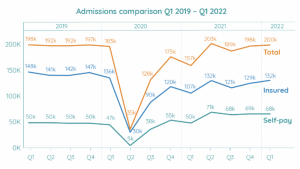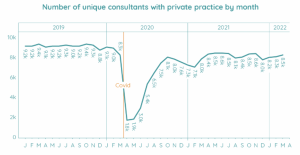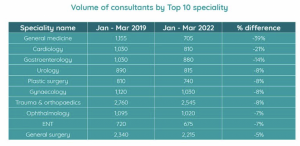A stream of recent media stories have pointed to the plight of patients suffering distressing delays in accessing NHS treatment. An increasing number have opted to ‘go-private’, dipping into savings to access faster treatment – becoming self payers as they are called in the industry. But figures released by the Private Healthcare Information Network shed a different light on this story, suggesting that overall use of private health sector is not expanding in the way that some of the media stories imply.
According to PHIN figures, admissions to independent hospitals are only slightly up when comparing figures for the most recent quarter with the equivalent period before the pandemic (198,000 – for quarter 1 of 2019 and 200,000 for Q1 of 2022).

There clearly has been a significant rise in self-pay patients – 39% since before the pandemic, which is the trend picked up in the media, but interestingly these hospitals are treating less patients with private medical insurance, compared to the same period before the pandemic.


PHIN figures also show that the Independent sector has 10% less active consultants working for it than in 2019. This is despite a sharp increase in their private sector activity since the height of the pandemic when consultants were doing a fraction of their current level of private work.
This perhaps mirrors some trends within the NHS where stress and overwork are forcing many to think about quitting or reducing their hours. However it also re-emphasises the reality that most consultants who work in the private sector also work for the NHS. To substantially increase their work in one sector will frequently mean a decrease in the other. In policy terms this means there is little scope to recruit the private sector in order to lessen the NHS elective waiting lists as, to a large degree, it is very often the same group of surgeons doing the work in both sectors.
Although the rise in self payers is being pronounced as a potential boom period for the independent sector it remains to be seen whether the big players in the sector will be able to convert their self pay customers into fully fledged private insurance policyholders. Despite long periods of underfunding in the NHS and previous eras where long waits are prevalent, the percentage of the population covered by private medical insurance has stubbornly remained flat at around 12%.
With the cost of living crisis biting ever deeper, and more broadly across society the NHS remains the only option for the vast majority of the population to access comprehensive healthcare. Despite policy makers leaning heavily on the independent sector in their plans to reduce NHS waiting lists, the reality is that only a rise in NHS capacity will provide a long term solution.
More…
Plan to tackle NHS queues lacks funding for staff, but favours private sector
Dear Reader,
If you like our content please support our campaigning journalism to protect health care for all.
Our goal is to inform people, hold our politicians to account and help to build change through evidence based ideas.
Everyone should have access to comprehensive healthcare, but our NHS needs support. You can help us to continue to counter bad policy, battle neglect of the NHS and correct dangerous mis-infomation.
Supporters of the NHS are crucial in sustaining our health service and with your help we will be able to engage more people in securing its future.
Please donate to help support our campaigning NHS research and journalism.


